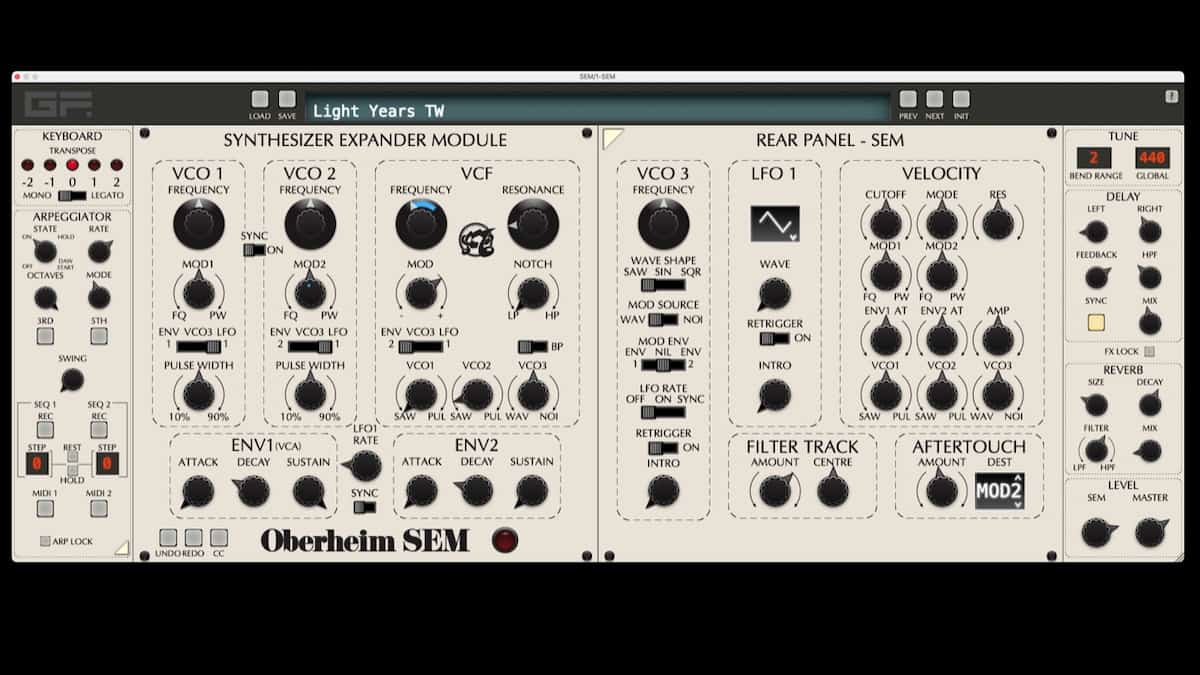In This Issue
GForce Oberheim SEM – Exclusive Synth and Software Review

It was just released today (Tom Oberheim’s birthday), and it’s a beauty
Okay, this is my new favorite synth (along with all my other favorite ones). GForce has just released – today, July 7, 2022 – a software Oberheim SEM module. It coincides with Tom Oberheim’s birthday. You read it here first.
This thing sounds just wonderful.
On the surface it’s a very simple “analog” synth, modeled after the original Oberheim instrument from 1974, but with a few added modern features. One of GForce’s pitches for the instruments: it has Tom Oberheim’s blessing (he consulted with them).
Did I mention how wonderful it sounds?
You know, let’s just start here by listening to some noodling. This is a factory patch called Bright Stars, straight out of the box with no tweaks (more examples of the instrument’s sound will follow below).
Check out how flat-out gorgeous it sounds across the whole register, also how smooth and free of cheap reverb boxiness and ugly sparkles the long ambient reverb is (it’s a GForce add-on).
GForce also has an Oberheim OB-E, the subsequent polyphonic synth containing eight SEM modules, which is also fantastic (and you can exchange single-module patches between the two). But they developed the single-module SEM precisely because of its simplicity and charm – and, they intimate, in the hope that a monophonic instrument will inspire musicians to put melody on the front burner.
As per the bumph, you’d have to work very hard to make the SEM sound bad. It’s an instrument you go for when you want to play a synthesizer, not play with one.
Overview. You can see what’s going on with this instrument just by looking at the interface.
The Synthesizer Expander Module section is the same as the original instrument’s panel, except that the original didn’t have undo/redo or the ability to assign MIDI CCs to synth parameters.
Obviously those are anachronistic, since there was no patch storage (just analog knobs) and MIDI was nine years later! And of course the “LED” display that shows patch names and parameter values when you move a knob wasn’t there.
GForce’s additions are on the Rear Panel section and all the stuff on the left – the arpeggiator and sequencer, etc.
As to the voice structure, two VCOs produce sawtooth or pulse waveforms. GForce added third one that does sawtooth, sine, square, and noise waves. It can also be used as a modulation source and produce FM sounds.
The two envelopes, from the original, are 3-stage – the sustain stage handles the release. That may sound primitive compared to a modern synth like Spectrasonics Omnisphere with practically unlimited numbers of envelope stages, but it really isn’t a limitation in the context of this monophonic instrument.
Oberheim’s design was intended to complement the sound of the Moog and Arp synths around at the time. And a big part of the SEM’s sound is due to its 12dB per octave multimode filter. Also new for 2022 (only 48 years later!): a selection of wave shapes for the LFO.
GForce added delay and reverb to the SEM, an important addition for today – one that the factory patches exploit, to the point that you’ll probably back them off a little in a mix. That the reverb in an inexpensive software synth sounds this good is especially impressive to those of us old enough to remember when all software reverbs sounded like buttocks compared to hardware.
One very minor request for a future version: some kind of on/off switch for each VCO, rather than having to center its knob and lose its setting when you want to focus on its contribution to the sound. But this is still a really easy and intuitive synth to program.
Sequencer and arpeggiator. Did GForce put a bottle of Michael Whalen in the SEM’s step sequencer?
Check out the factory patch called A Dreamy Sine, which includes the sequence stored with it:
Now listen to the title track from Imaginary Trains!
Anyway. The arpeggiator does what you’d expect from an arpeggiator, with the addition of buttons to raise the patterns by a third or a fifth above the notes you play. They also affect the two 32-note step sequencers (you get one at a time).
Using the sequencers is very simple: press Rec and play in notes, using the Rest and Hold buttons on the SEM if you want. You have to start over if you goof, unfortunately, but you can just drag and drop the MIDI onto a track in your DAW and edit it there instead.
The sequencer is useful for examples like the one above, or for more abstract riffs – for example this one (which was noodled by your friendly not-a-real-keyboard-player reviewer):
Bottom line. Like all synths, the SEM is capable of doing a lot of different things. But it just does what you’d want a monophonic analog synth to do really well.
Here’s a synth bass, for example (spartan synth drums courtesy of GForce’s OB-E):
So: a rave review. The SEM is an Officially Certified go-to instrument for gorgeous analog sounds.
Price: £49.99 +VAT with an intro price of £29.99 + VAT















